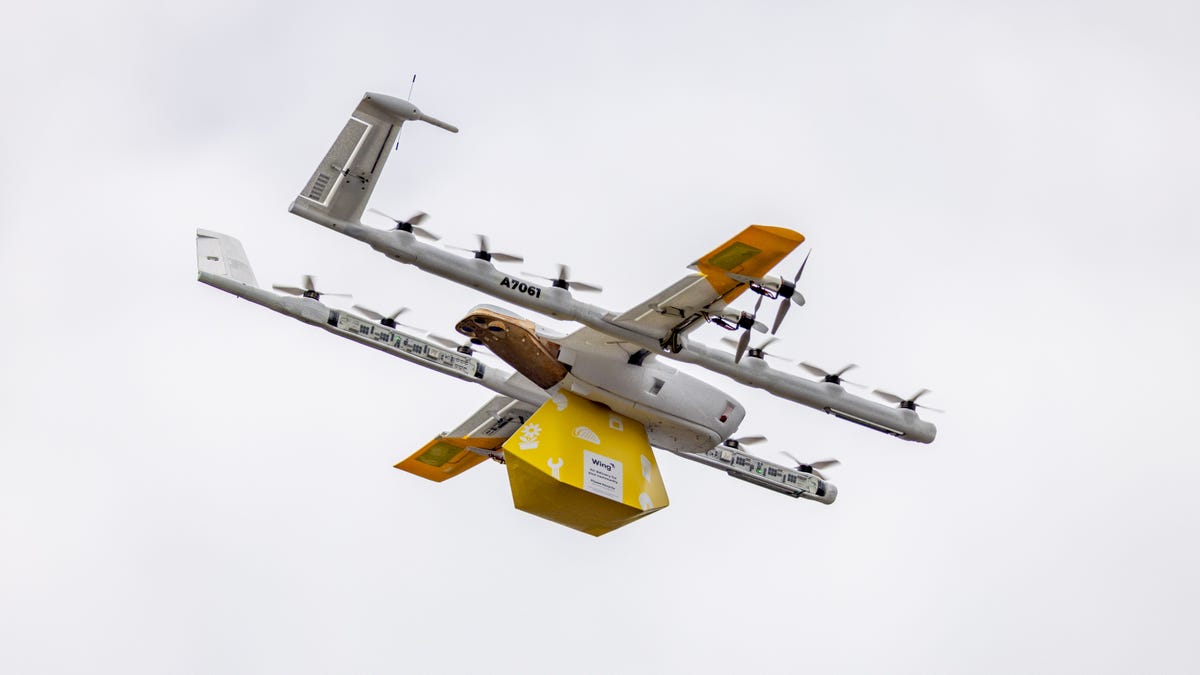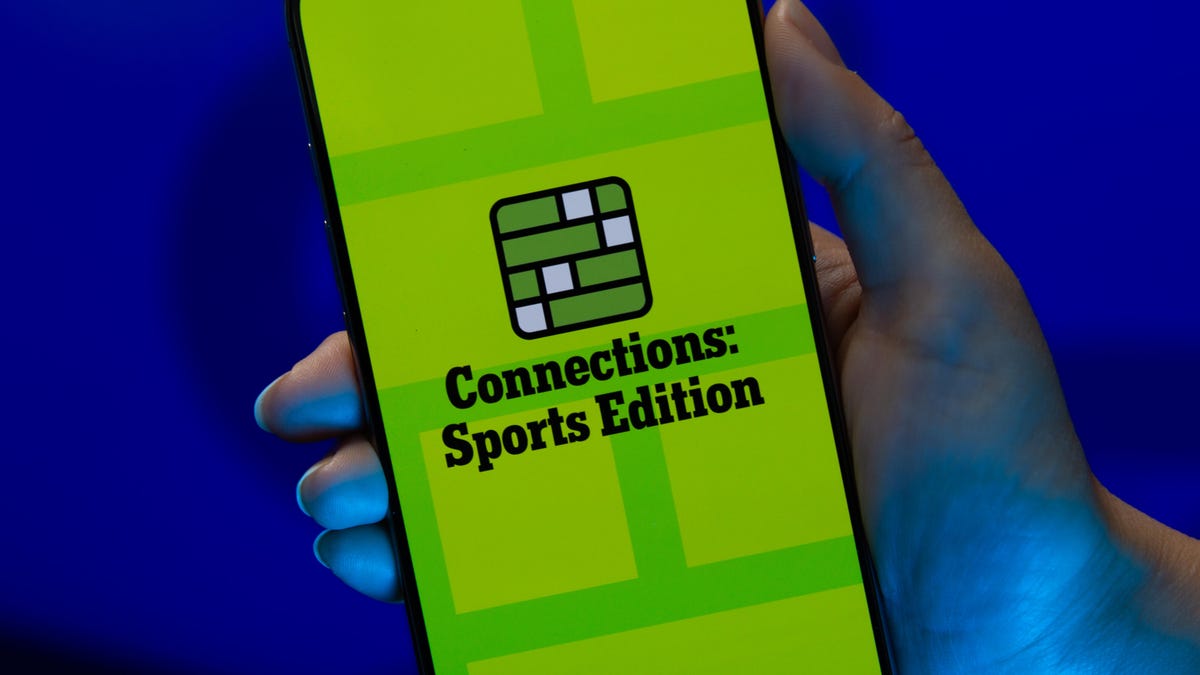Technologies
Expect Smoother Drone Delivery With Wing’s Autoloader
The Alphabet effort publicly demonstrates a launch station it hopes will make it easier for retailers to whisk burritos and aspirin to your home.

Wing, the drone delivery subsidiary from Google parent company Alphabet, has shown publicly for the first time the «autoloader» station it expects will make it significantly easier for retailers to send products through the air to customers.
The autoloader, announced in March and set to be deployed later this year, is a Y-shaped stand that easily fits in a parking space. A company employee hangs a delivery box on a pair of hooks on the autoloader then returns to work. There’s no need to wait for the drone to arrive, because it can snag the package on its own by lowering a yellow hook to the autoloader station.
Adding the autoloader may seem like a minor change, but it paves the way for a potentially massive expansion of drone delivery. Instead of operating isolated base stations, Wing envisions a fleet of drones autonomously dispatched across a network of delivery and charging stations, hopping from one destination to another with a minimum of human intervention. Inexpensive autoloaders make it easier to bring new retailers into the network.
Drone delivery today remains limited by regulators who limit its expansion to a few pockets, but the regulations are maturing along with the technology. Expect millions of us to be within drone delivery range this year from Wing and rival drone delivery efforts from Zipline, Amazon, Drone Express, Matternet, DroneUp, Manna and others.
Wing demonstrated its autoloader technology in a company parking lot at offices in Palo Alto, California, flying packages to a nearby courtyard. It took no special measures to avoid people, trees and cars other than blocking off three parking spots with traffic cones, a sign that Chief Executive Adam Woodworth said shows how mature operations have become.
«We are at the point in this journey where I think that this is a thing that’s going to happen,» Woodworth said. Wing has made more than 340,000 drone deliveries so far with operations in Australia, Finland, Virginia and Texas.
The autoloader has no computer controls or moving parts, but it’s still pretty sophisticated. The two upward pointing poles help guide the drone’s hook, dangling from a string below the hovering drone, to a narrow slot that aligns the hook properly to latch onto the waterproof, recyclable package.
The slot, package and drone hook are all designed to work together. For example, the hook will grab the package only once it’s pushed through the hole on the package. Its round bottom won’t bump back in to regrab it after release.
«It’ll save a lot of time for the user. Instead of going to the store and picking something up, you’re staying at home and waiting for the drone to deliver it to your doorstep,» said Wing marketing chief Jonathan Bass. «For a worker, they can essentially place the package on the auto letter, go back inside and continue working. We think it will save a lot of time.»
The drones, made chiefly of foam, weigh 11 pounds each and can carry a payload up to 3.3 pounds.
«We do expect to introduce aircraft that can deliver larger payloads and some smaller [aircraft] that might be longer range,» Bass said.
Today, Wing’s drones have a range of 6 miles, though bing part of a Wing delivery network, with a mesh of destinations, will extend that since Wing can offer wireless charging pads in more locations.
Will we someday see delivery drones blackening the skies? Not likely, Woodworth believes. Even with current operations launching 1,000 flights a day, which can mean one every 30 seconds or so, drones are unusual.
«The sky is really big,» Woodworth said. «Even at full scale, you’re not going to look up and see tons of airplanes.»
Technologies
Today’s NYT Connections: Sports Edition Hints and Answers for Nov. 29, #432
Here are hints and the answers for the NYT Connections: Sports Edition puzzle for Nov. 29, No. 432.

Looking for the most recent regular Connections answers? Click here for today’s Connections hints, as well as our daily answers and hints for The New York Times Mini Crossword, Wordle and Strands puzzles.
It’s Rivalry Saturday, so Connections: Sports Edition gives a big game a nod with two caregories. If you’re struggling with today’s puzzle but still want to solve it, read on for hints and the answers.
Connections: Sports Edition is published by The Athletic, the subscription-based sports journalism site owned by The Times. It doesn’t appear in the NYT Games app, but it does in The Athletic’s own app. Or you can play it for free online.
Read more: NYT Connections: Sports Edition Puzzle Comes Out of Beta
Hints for today’s Connections: Sports Edition groups
Here are four hints for the groupings in today’s Connections: Sports Edition puzzle, ranked from the easiest yellow group to the tough (and sometimes bizarre) purple group.
Yellow group hint: Fire it on in there.
Green group hint: Buckeyes.
Blue group hint: Wolverines.
Purple group hint: Not double.
Answers for today’s Connections: Sports Edition groups
Yellow group: Baseball pitching feats.
Green group: Associated with Ohio State.
Blue group: Associated with Michigan.
Purple group: Triple ____.
Read more: Wordle Cheat Sheet: Here Are the Most Popular Letters Used in English Words
What are today’s Connections: Sports Edition answers?
The yellow words in today’s Connections
The theme is baseball pitching feats. The four answers are immaculate inning, no-hitter, perfect game and shutout.
The green words in today’s Connections
The theme is associated with Ohio State. The four answers are dotting the I, gray, scarlet and The Horseshoe.
The blue words in today’s Connections
The theme is associated with Michigan. The four answers are blue, Hail to the Victors, maize and The Big House.
The purple words in today’s Connections
The theme is triple ____. The four answers are A, crown, double and play.
Technologies
Today’s NYT Mini Crossword Answers for Saturday, Nov. 29
Here are the answers for The New York Times Mini Crossword for Nov. 29.

Looking for the most recent Mini Crossword answer? Click here for today’s Mini Crossword hints, as well as our daily answers and hints for The New York Times Wordle, Strands, Connections and Connections: Sports Edition puzzles.
Need some help with today’s Mini Crossword? It’s Saturday, so it’s a long one. Read on for all the answers. And if you could use some hints and guidance for daily solving, check out our Mini Crossword tips.
If you’re looking for today’s Wordle, Connections, Connections: Sports Edition and Strands answers, you can visit CNET’s NYT puzzle hints page.
Read more: Tips and Tricks for Solving The New York Times Mini Crossword
Let’s get to those Mini Crossword clues and answers.
Mini across clues and answers
1A clue: Hockey disks
Answer: PUCKS
6A clue: Signature headwear for Mr. Monopoly
Answer: TOPHAT
7A clue: Seedy establishment?
Answer: NURSERY
8A clue: Bioweapon at the center of a 2001 envelope scare
Answer: ANTHRAX
9A clue: Cleverly skillful
Answer: ADROIT
10A clue: Sleeping enclosure for a pet dog
Answer: CRATE
11A clue: Picks up the tab
Answer: PAYS
Mini down clues and answers
1D clue: Play, as a film character
Answer: PORTRAY
2D clue: Ultimate consequences
Answer: UPSHOTS
3D clue: Sweetheart, in French
Answer: CHERIE
4D clue: 24-___ gold
Answer: KARAT
5D clue: River in which Achilles was dipped (except for his heel!)
Answer: STYX
6D clue: Frozen landscape
Answer: TUNDRA
7D clue: Civil rights org. co-founded by W.E.B. Du Bois
Answer: NAACP
Don’t miss any of our unbiased tech content and lab-based reviews. Add CNET as a preferred Google source.
Technologies
Repair Your Electronics at Home With This Rare Black Friday Discount on the iFixit Pro Tech Go Toolkit
This toolkit rarely goes on sale, so take advantage of this opportunity to snag it for only $40.

While Black Friday is an excellent time to replace old smartphones or broken laptops at a discount, not everyone is looking to splurge on new tech right now. If you’re shopping on a budget, or simply like the devices that you have and aren’t ready for an upgrade, investing in an electronics repair kit may be a wise option. We’ve spotted a discount on the iFixit Pro Tech Go tech toolkit, bringing its price down to just $40. But don’t delay, Black Friday is in its final hours and this kit rarely goes on sale.
The iFixit Pro Tech Go kit can be used to open up and repair a wide range of electronics, including smartphones, laptops, gaming consoles, and smart home devices for DIY repairs like battery or screen replacements. The kit has a 32-bit Moray driver kit, an opening tool, a suction handle, a jimmy, a spudger and angled tweezer to carefully open your devices.
Don’t miss any of our unbiased tech content and lab-based reviews. Add CNET as a preferred Google source.
Repairing your own tech can save you hundreds or even thousands of dollars. It also reduces e-waste by helping your devices last longer rather than throwing them away over minor issue. As of this year, all 50 states have introduced right-to-repair legislation designed to give people a legal right to fix their own tech, and several states have already signed it into law.
You can check out more deals from iFixIt now on Amazon. Plus, for other budget buys, check out our roundup of the best Black Friday deals under $100.
MOBILE DEALS OF THE WEEK
-
$749 (save $250)
-
$475 (save $175)
-
$499 (save $300)
-
$900 (save $400)
Why this deal matters
This is a record low price on a repair kit that rarely goes on sale. While we did see a modest discount on the iFixit Pro Tech Go toolkit during Amazon Prime Day in July, it was not marked down for October Prime Day or other sales such as Memorial Day or Labor Day. As such, it’s fairly unlikely that we’ll see it go on sale again this season, so this might be your last chance to get the toolkit for only $40.
Join Our Daily Deals Text Group!
Get hand-picked deals from CNET shopping experts straight to your phone.
By signing up, you confirm you are 16+ and agree to receive recurring marketing messages at the phone number provided. Consent is not a condition of purchase. Reply STOP to unsubscribe. Msg & data rates may apply. View our Privacy Policy and Terms of Use.
-

 Technologies3 года ago
Technologies3 года agoTech Companies Need to Be Held Accountable for Security, Experts Say
-

 Technologies3 года ago
Technologies3 года agoBest Handheld Game Console in 2023
-

 Technologies3 года ago
Technologies3 года agoTighten Up Your VR Game With the Best Head Straps for Quest 2
-

 Technologies4 года ago
Technologies4 года agoBlack Friday 2021: The best deals on TVs, headphones, kitchenware, and more
-

 Technologies4 года ago
Technologies4 года agoVerum, Wickr and Threema: next generation secured messengers
-

 Technologies4 года ago
Technologies4 года agoGoogle to require vaccinations as Silicon Valley rethinks return-to-office policies
-

 Technologies4 года ago
Technologies4 года agoOlivia Harlan Dekker for Verum Messenger
-

 Technologies4 года ago
Technologies4 года agoiPhone 13 event: How to watch Apple’s big announcement tomorrow
